
Top page ( quantum mechanics is wrong. ← 6/30/2024 ).
True nature of molecular bond (H2).
Strange "Spin" is NOT a real thing.
Special relativity is wrong.
(Fig.1) Superposition = unrealistic Many-worlds !

As you know, quantum mechanics cannot describe the electron's concrete motion at all.
It only shows the probability density of the electron in hydrogen atom.
So to explain wavefunction collapse, they need unrealistic many worlds.
And we proved quantum mechanical Schrodinger equation can never have true wavefunction for H2+ molecule ion or multi-electron atoms due to this quantum mechanical unrealistically-spreading probability wavefunction.
(Fig.2) 1 × de Broglie wavelength = hydrogen ground state.
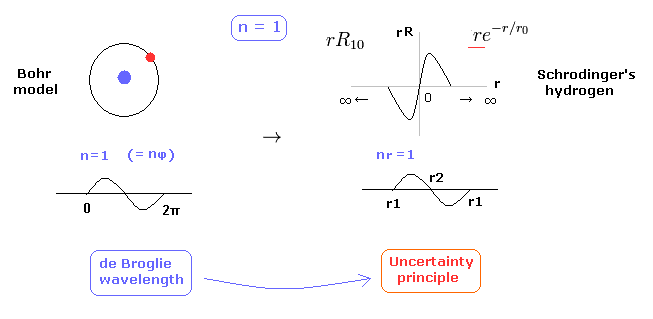
As shown in this page, Schrodinger's hydrogen also satisfies the condition of an integer times de Broglie wavelength.
This is the reason why Schrodinger's hydrogen gives completely the same results as Bohr model.
As shown in Fig.2, in the ground state of hydrogen atom, Bohr model consists of tangential de Broglie wave, and Schrodinger's model ( rR ) consists of "radial" de Broglie wave.
( It is easily understood also by seeing the probability graphs of |rR|2. )
Actually, the probability of ground state of hydrogen is the highest around Bohr radius.
The problem is that Schrodinger's radial wavefunction must be always from zero to infinity.
And the 1s de Broglie wave is linear, so the opposite phases of them overlap and cancel each other out.
(Fig.3) Schrodinger's wavefunctions always spread to infinity.
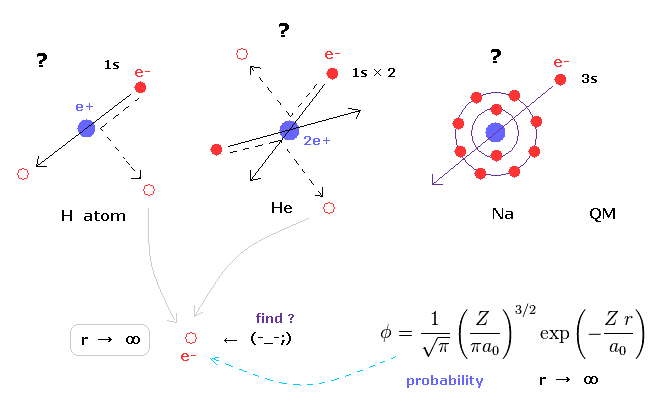
In various atoms and molecules such as helium and hydrogen molecule, Schrodinger's wavefunction ALWAYS spread to infinity.
This means we can find the bound-state electron at infinity even in very stable helium atom !
Of course, this is impossible, and quantum mechanics ( chemistry ) has NO ability to describe real states of various atoms and molecules.
Schrodinger's equation of helium atom cannot be solved, but variational functions of it are always spreading to infinity.
(Fig.4) Schrodinger's 2P "radial" wave function (angular momentum = 1).

As shown in Fig.4, the 2P "radial" wave function ( χ = rR21 ) contains the regions of the minus kinetic energy ( r < a1, a2 < r ).
When the r is bigger than a2, the Coulomb potential energy becomes higher than some maximum value.
In this region, to keep the total energy (E < 0) constant, the "radial" kinetic energy must be minus !
Furthermore, in the region from 0 to a1 of Fig,4, the potential energy is lower than the total energy.
But the tangential kinetic energy increases much faster than others.
To cancel the increased tangential kinetic energy, radial kinetic energy has to be minus.
These unreasonable states clearly show Schrodinger's hydrogen atom is wrong.
(Fig.5) Quantum mecanical helium becomes chaotic and unstable.
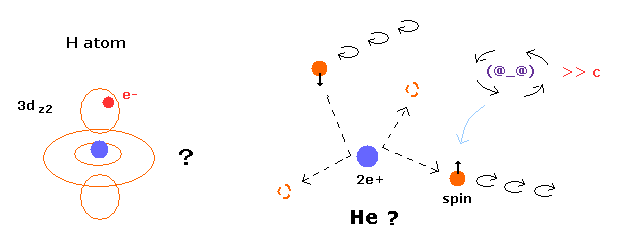
In the quantum chemistry, if we use two 1s wavefunction of hydrogen atom, we can get the approximate gound state energy of helium.
But as you notice, 1s state has NO angular momentum.
In this state, two electrons of helium become chaotic and very unstable due to repulsive Coulomb force between them.
So the quantum mechanical helium is completely different from the actual helium atom.
(Fig.6) Quantum mechanical helium.

To get the exact ground state energy of helium (or hydrogen molecule ) using Schrodinger's equation, we have to use more than a thousand variational functions, as shown in Fig.6.
(Fig.7) Probability density of helium or H2 ?

And these variational functions must include the variables (= r12 ) which express the distance between two electrons.
So, different from static hydrogen atom, the probability density at which we find electron 1 of helium (or H2 ) is always changing depending on the position of electron 2.
This variational functions of helium clearly shows the two electrons of helium are actually moving, even in the vague probability density waves.
(Fig.8) Reduced mass = electrons and nucleus are actually moving !

As you know, if we use the reduced mass of electron, we can get more exact values of the energy levels even in hydrogen atom.
This fact clearly shows that the electron and nucleus are actually moving interacting with each other.
Of course, as fractional charges of electron have not been found, we have to express real motions of the two electrons in helium atom.
As shown in this page, even pilot wave (Bohm) theory cannot explain two-electron helium at all, in quantum mechanics.
(Fig.9) Calculation results using reduced mass are more exact.

The experimental value of ground state hydrogen is -13.598 eV.
When we calculate this ground state energy using Schrodinger equation (or Bohr model ), it becomes -13.606 eV.
If we replace the usual electron mass by reduced mass considering nuclear motion, this calculation result becomes more exact (= -13.598 eV ).
This fact clearly shows the bound-state electron (and nucleus ) is actually moving.
Also in helium ion ( He+ ), if we use reduced mass, we can get more exact result (= -54.415 eV ) than the usual electron mass (= -54.423 eV ).
The experimental value of He+ is -54.417 eV.
(Fig.10) Two-electron Atomic Model ( He, Li+, Be2+, B3+, C4+ ... )
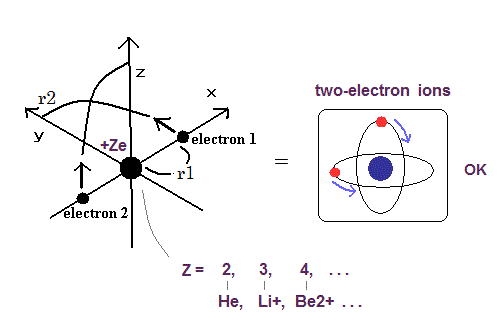
As shown in Top page, if the two de Broglie waves (= 1 × wavelength ) are overlapping each other, their opposite wave phases cancel each other due to destructive interference.
( These destructive interferences of electron's de Broglie waves were actually observed in Davisson and Germer experiments. )
So the two electrons's orbit have to be perpendicular to each other to avoid destructive inteference.
| Atoms | r1 (MM) | WN x 4 | Circular orbit | Result (eV) | Experiment | Error (eV) |
|---|---|---|---|---|---|---|
| He | 3074.0 | 1.000000 | -83.335 | -79.0037 | -79.0051 | 0.001 |
| Li+ | 1944.5 | 1.000000 | -205.78 | -198.984 | -198.093 | -0.89 |
| Be2+ | 1422.0 | 1.000000 | -382.66 | -373.470 | -371.615 | -1.85 |
| B3+ | 1121.0 | 1.000000 | -613.96 | -602.32 | -599.60 | -2.72 |
| C4+ | 925.0 | 1.000000 | -899.67 | -885.6 | -882.1 | -3.50 |
| N5+ | 788.0 | 1.000000 | -1239.8 | -1223.3 | -1219.1 | -4.20 |
| O6+ | 685.3 | 1.000000 | -1634.38 | -1615.44 | -1610.70 | -4.74 |
| F7+ | 607.3 | 1.000000 | -2083.3 | -2062.0 | -2057.0 | -5.00 |
| Ne8+ | 544.5 | 1.000000 | -2586.7 | -2563.0 | -2558.0 | -5.00 |
As shown in Table.1, these two-electron atomic model can completely explain actual energy states of various atoms.
The helium ground state energy ( -79.0037 eV ) is more exact than the latest quantum mechanical variational methods ( -79.015 eV ), because quantum mechanical helium cannot deal with nuclear motion ( reduced mass ) correctly.
About the computing methods and programs, see this page.
And this model can express three-electron atoms such as lithium correctly, too.
(Fig.11) New Bohr's helium (= A.) is not electrically polarized.

Furthermore, this helium model is just consistent with the fact that helium atom is most stable and doesn't form compounds with other atoms (or itself ).
Because when the two orbits are perpendicular to each other, the space around 2e+ nucleus becomes just neutral due to uniform distribution.
And of course, there is no space into which the third electron enter in Fig.10 helium, considering the stability of de Broglie waves (= Pauli exclusion principle ).
If the third electron enter them, destructive interferences of their de Broglie waves make them unstable.
(Fig.12) "Mathematical" Schrodinger equation vs. "real" Bohr model.

We cannot know what the Schrodinger's wavefunctions really are and just give up asking what they are.
Furthermore, as shown in this page, even if we study about relativistic quantum field theory and string theory, we cannot know what mysterious Pauli exclusion principle really is.
They just insist anticommutation of mathematical operators means Pauli exclusion principle.
So, as shown in this page, we cannot develop and try easier and useful methods in this very limited and vague conditions.
As this useless present quantum chemistry cannot be applied to various fields such as molecular biology and nanotechnology, their developments all stop now in the molecular levels. This is serious problem.
(Fig.13) Density functional theory = approximation.

First, density functional theory (= DFT ), which is often used now, is only approximation, and NOT ab-initio method.
DFT is one of semi-empirical methods.
We can artificially choose various approximations such as LDA to match experimental results.
So popular DFT itself is NOT a true theory.
(Fig.14) Quantum mechanical hydrogen molecule ion ( H2+ ) ?

First we need to know the quantum mechanics can never find true solution or wavefunction of Schrodinger equation for hydrogen molecule ion H2+ (= finding true wavefunction giving the constant conserved total energy E regardless of electron's positions is impossible ), so quantum mechanics is false.
Unlike hydrogen atom, the wavefunction of H2+ molecule ion itself does NOT mean real probability density of electrons.
So we cannot know the real states of an electron from this quantum mechanical H2+ molecule ion.
(Eq.1) H2+ molecule ion Hamiltonian.

Eq.1 consists of kinetic energy of an electron and Coulomb interactions among one electron and two nuclei ( a and b ).
Internuclear distance of H2+ is very long (= 1.057 × 10-10 m ).
So it is natural that we think electron probability distribution around one nucleus is almost same as hydrogen atom.
So they define H2+ wavefunction using the 1s H atom wavefunction as follows,
(Eq.2) H2+ molecule ion wavefunction.

where a0 is Bohr radius.
c1 and c2 are variational parameters.
Subsitituting Eq.1 and Eq.2 into the following energy equation,
(Eq.3)

where
(Eq.4)

This is called overlap integral.
Solving Eq.3 using ellipsoidal coordinate, we obtain
(Eq.5)

Re is internuclear distance, and De is dissociating ( binding ) energy of H2+ ( H2+ → H + H+ ).
The calculation result of Eq.5 is different from the experimental results of
(Eq.6) Experimental results of H2+

So they change the wavefunction of Eq.2 into the following one, and increase the variational parameters.
( But I think, this manipulation is very artificial ONLY to get the exact values. )
(Eq.7)

where
(Eq.8)

In Eq.8 χ1 is the 1s hydrogen atom wavefunction, and χ2 is 2p H atom wavefunction.
σ, Z' and Z'' are variational parameters.
They insist 2p wavefunction can describe the electron distribution between two nuclei naturally.
But they should explain the reason why this 2p must not be (different Z) 1s, 2s or other things.
Calculation results based on Eq.7 are
(Eq.9)

This result is closer to the experimental value of Eq.6.
But as you see in Eq.9, the positive charge of 2p wavefunction becomes 2.868.
Of course, H2+ molecule ion has only 2 nuclei, so Z'' = 2.868 is impossible.
So their insistence that 2p wavefunction express internuclear electron distribution is inconsistent with real H2+ molecule ion structure.
And considering the angular momentum conservation, the change from 2p to 1s is also impossible.
As a result, the wavefunction of Eq.7 does NOT mean the real H2+ electron.
( See also truth of variational method about why strange Z'' = 2.868 is gotten. )
(Fig.15) Two nuclei of H2+ molecule ion
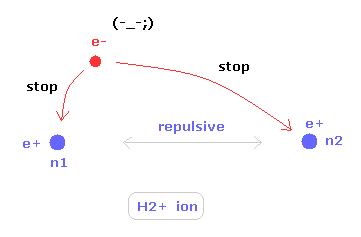
In some special condition, unstable hydrogen molecule ion (H2+) can exsit.
The hydrogen molecule ion has two positive nuclei and one negative electron.
To keep the two nuclei's positions stable, this only electron needs to move around more actively than hydrogen molecule.
So, H2+ molecule ion is completely different from helium atom, because the electron needs to keep two nuclei stable only by its movement.
Additional movement (= precession ) is very important especially in H2+ molecule ion.
(Fig.16) Two nuclei of H2 molecule

Different from H2+ molecule ion, H2 molecule has two electrons.
So each electron is moving to keep mainly one of the two nuclei stable.
If one of the two nuclei becomes stable, another nucleus is automatically stable due to the symmetric structure.
As a result, the electrons of H2 molecule don't need to move and shake like H2+ ion.
All stable molecular bonds are based on this hydrogen molecule (H2) rather than very special form of H2+.
So if you want to know the true nature of molecular bond, see hydrogen molecule (H2) page.
(Fig.17) Bohr model H2+ molecule ion

Here we calculate the number of de Broglie wave in one orbit using Fig.17 model and following programs.
Sample JAVA program of H2+ molecule ion.
C language program of H2+ molecule ion.
Here we use the new unit of 1 MM = 1 × 10-14 meter.
In this program, first we input the internuclear distance (= nuc in MM ) of H2+.
And then input y-coordinate "r" (in MM) , and x-coordinate "a" ( in MM ) of an electron.
(Fig.18) First, we stop nucleus 2.
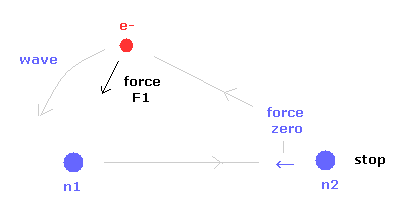
First, we find the electron's position at which nucleus 2 (=n2) stops.
( When the x component of forces acting on n2 is zero. )
So in this case, the ratio of forces ( from electron and n1 ) acting on n2 is just 1.000.
F1 is the total force acting on electron toward nucleus 1 (= n1 ).
From the inputed values ( a, r, nuc ), we calculate the total potential energy V.
Using Virial theorem, we can get the total energy E = 1/2 V and kinetic energy T = -1/2 V.
From this kinetic energy we obtain the electron's velocity (= v ) and de Broglie wavelength (= h/mv ).
(Eq.10)

Due to the long internuclear distance, we suppose the electron is mainly orbiting around the nucleus 1, and calculate the centrifugal force (cf).
And we calculate the total force (F1) acting on the electron 1 toward the nucleus 1 as follows,
(Eq.11)

The first term is the Coulomb force between the nucleus 1 (n1) and the electron, the second term is the Coulomb force by the nucleus 2 (n2).
The θ is the angle between rra and rrb ( see Fig.17 )
Suprinsingly, when the nucleus 2 stops, the ratio of F1 to the centrifugal force (= cf ) around n1 is just 1.000 ( Eq.10 = Eq.11 ).
So we calculate the number of the de Broglie's waves (W1) contained in this circular orbit as follows,
( Based on the fact that the above centrifugal force is just equal to the Coulomb force F1, we suppose the electron is orbiting around the nucleus 1 on almost "circular" orbit here. But actually, the electron is moving "more complexly". )
(Eq.12)

where h is the Plank's constant, and h/mv is the de Broglie's wavelength.
Due to this circular orbit around n1, nucleus 1 becomes stable.
In hydrogen molecule with two electrons, this process can be omitted.
(Fig.19) Precession around x axis.

And furthermore, we suppose the "precession" around the x axis, which is caused by the y component of the Coulomb force from nucleus 2.
Considering the centrifugal force is equal to the Coulomb force , the equation of the motion becomes,
(Eq.13)

where r is the distance between the electron and the x axis, and vp is the electron's precession velocity around the x axis.
Considering this precession is caused by the existence of nucleus 2, th right side of Eq.13 is the y compount of force by nucleus 2.
The time period of the rotation around the nucleus 1 is T = 2 π × (rra) / v.
For this time period, the electron moves T × vp around the x axis.
So we need to add these de Broglie's waves to the above value.
The number of these additional de Broglie's waves (W2) is,
(Eq.14)

So the total de Broglie waves is the sum of Eq.12 and Eq.14.
Table 2 shows the results at various internuclear distances (= nuc ), when the force acting on n2 is zero, and total de Broglie waves is just 1.000.
" n2 force " means the ratio of forces ( from electron and n1 ) acting on n2.
When this ratio is 1.000, force acting on n2 is in equilibrium.
| nuc (MM) | r (MM) | a (MM) | Energy (eV) | centrifugal | n2 force | total waves | new waves |
|---|---|---|---|---|---|---|---|
| 8000 | 3707 | 1537 | 4.998 | 1.000 | 1.000 | 1.000 | 0.996 |
| 9000 | 3940.5 | 1507 | 3.964 | 1.000 | 1.000 | 1.000 | 0.998 |
| 10000 | 4136 | 1460 | 3.196 | 1.000 | 1.000 | 1.000 | 0.999 |
| 10570 | 4237 | 1436 | 2.826 | 1.000 | 1.000 | 1.000 | 1.000 |
| 11000 | 4304 | 1415 | 2.592 | 1.000 | 1.000 | 1.000 | 1.000 |
| 11500 | 4381 | 1390 | 2.332 | 1.000 | 1.000 | 1.000 | 1.001 |
| 12000 | 4448 | 1370 | 2.112 | 1.000 | 1.000 | 1.000 | 1.001 |
Energy means binding energy of H2+ ion.
And "centrifugal" means the ratio of force F1 (= Eq.11 ) to centrifugal force (= Eq.10 ) around nucleus 1.
As shown in Table 2, as internuclear distance is longer, the binding energy becomes smaller.
(Fig.20) Precession around x axis.

When calculating total de Broglie wave, we neglect the attractive force in the x direction by nucleus 2.
So we also add or subtract this attractive force at two end points ( upper and lower of x axis ).
Using these new calculated force acting on electron, new de Broglie waves (= new waves ) are gotten.
As shown in Table 2, as the internuclear distance becomes shorter ( than 10570 MM ), new de Broglie waves becomes shorter than 1.000.
Experimantal values of H2+ ion is
(Eq.15) Experimental results of H2+

So around the experimental value of nuc = 10570 MM, total de Broglie wave is almost 1.000 and the binding energy is close to the experimental velue.
But different from hydrogen molecule, the single electron needs to take care of two nuclei at the same time.
(Fig.21) Two nuclei of H2+ molecule ion

So this electron's motion is not just a simple rotation, it is actively moving in unstable H2+ ion.
But the electron is clearly quantized (= not divided ) particle, and variational method of the quantum mechanics gives unrealistic variational charge, as shown in Eq.9.
(Fig.22) Estimated "real" hydrogen molecule ion (H2+)
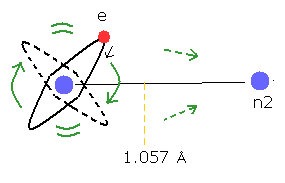
This motion of unstable H2+ ion is more complicated than other stable molecules as shown in this page.
I'm very glad if someones ( including specialists ) find more exact and realistic H2+ structure.

2010/7/18 updated. Feel free to link to this site.